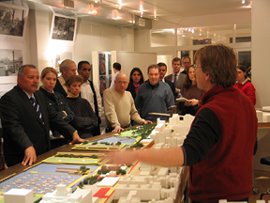What Public Process?

Image from Brooklyn Bridge Park Conservancy
Nicholas Confessore wrote a piece in the Times recently about bloggers’ public postings on the project. Norman Oder, on the Atlantic Yards Report, and others have responded. How is the project being informed by public discussion? On FCRC’s web site, in a section called Public Process, it is claimed that:
“In addition to numerous meetings FCRC has held with community organizations, local leaders and elected officials, the general public had the opportunity to participate at the Public Scoping meeting held by ESDC on October 18, 2005. The public submitted comments on the Draft Scope of Analysis which explains in detail the environmental issues that will be analyzed in the DEIS”
So we have been informed that the public review process has begun, because in addition to private meetings, there was a public meeting for the Draft Scope of Analysis for the Environmental Impact Statement (EIS). (A record of the “numerous” private meetings would be helpful, because behind the blogging issue is a general sense that the information is not getting through.) Let’s be clear about what that meeting for the “general public” was. The meeting was not a discussion about the project. The stated purpose of the meeting was to receive comments on the proposed scope of a proposed study of the project’s impact, as narrowly defined as that is by the state’s EIS process. Ironically, the EIS does not include issues of sustainable design, security, or other critical design issues; the EIS is not even a full discussion of the project’s impact. While the scope of the study was discussed, the specific impact of the project on the local area was not the subject of the meeting. Again, the discussion was supposed to be only about the scope of a study, which is quite different from a discussion about the project itself. A real discussion about the project would address the process, the financing, the schedule, and the idea of what this project means for Brooklyn.
Why does this matter? A successful design must ultimately synthesize all the constraints on the site and program in a way that appears seamless. To do that, the design team, including the funding parties, must fully understand the issues as perceived by all stakeholders. And a successful design must be seen to understand them by reaching out to the local communities, not just to self-appointed representatives. This is not “design by committee”, but a necessary recognition that there is important information in people’s opinions that should inform the design. We don’t need more public meetings to talk about the scope of a study. We do need real public discussions about the site, the program, the design, and the process.

0 Comments:
Post a Comment
<< Home